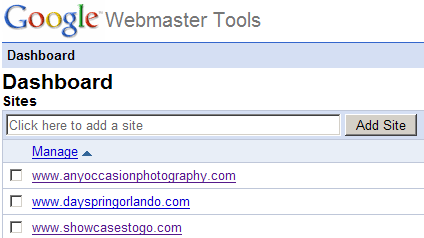Google Webmaster Tools
Google's Webmaster Tools are a free service that Google uses to help webmasters see how Google sees them. As it is a tool from Google, it will not show how Yahoo, MSN, or any other search engine sees your site. But as most search engines are similar in nature, if one has a problem, the other probably will as well.
Creating an Account
You need to have a Google Account to use Webmaster Tools. If you already have your an account, sign in, and look for the "Try something New" then look for Webmaster Tools. You can also just go to: www.google.com/webmasters/tools
Dashboard
 The Dashboard allows you to see your various accounts. You can have an unlimited number of accounts on your system. However, you do have to be able to prove that they are yours.
The Dashboard allows you to see your various accounts. You can have an unlimited number of accounts on your system. However, you do have to be able to prove that they are yours.
It is also each to add a new site to the list. Just use the "Add Site" button. You will have to go to the tools to prove you have access to the site. Generally the easiest way is to create an empty file with a name given to you, by Google. Once the file is uploaded, it will take a little while to gather data for you, but it can begin soon.
To manage one of the existing sites, simply click on the site name, and it will take you to the site's overview page.
Site Overview
 As one would expect, the site overview gives you a quick run down of potential issues in your site.
As one would expect, the site overview gives you a quick run down of potential issues in your site.
There are 7 categories that it will show errors for. This may or may not be in your control.
When errors are found, you can click on details to see what the error is, and if there is anything you can do about it.
Common Tools Used
Diagnostics
I like to look a Web Crawl and at Content Analysis.
Web Crawl lets you know the errors that you see on the overview page, so it is easy to review. You can also look for Mobile crawl if your site is designed for portable devices like mobile phones.
Content Analysis lets you check to see if you have pages with duplicate page titles, duplicate meta description tags etc.
Clicking on a link will give you more information about the potential errors it has found.
You can also click on the More Information to find out additional information about the topic that you are on. These are the Webmaster Guidelines according to Google.
Statistics
All of these are important, but I consider Top Search Queries and What Google Bot Sees to be the two most important. With this information, you can start to edit your pages based upon what people are searching for to improve your rankings.
With Top Search Queries, you are shown queries to Google, based relevancy to your site. The are listed by frequency of people searching, the the term, then where you rank for that term. You can also use the pull down tool to change and get a historical look over time. The Right column shows where your links are coming from. So if you notice, you will often see that some queries do not generate any links for you (from Google at least).
Sitemaps
Sitemaps allow you to define where your pages are to the Search Engines. All of the major Search Engines (Google, MSN, and Yahoo) have agreed upon the format. It is an XML file, and you can find services on-line that will provide this information for you.
This section lets you see if you have any errors.
Tools
Various tools for defining preferences on your site. It also helps with your robots.txt file. Robots.txt allow bots to know what pages to search and not search. This reduces the workload of your sites in serving up pages to the search engines, especially if you have pages you do not want them to search.
Why don't my updates show immediately?
Great question. And there is a simple reason. Search Engines use bots to search the web for data. At times they will revisit a site based upon links that see, how often pages are updated, etc.
Since the odds of you updating your site, just moments before Google revisits and recalculates your pages are slim, it may take several days to see your warnings, suggestions change. This is the same for the results in the search engine as well. Updates may take as long as a month or two to show up. Some sites see changes more frequently because of how much content they have, and/or how often they add content.